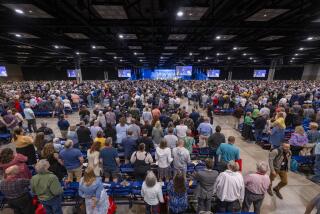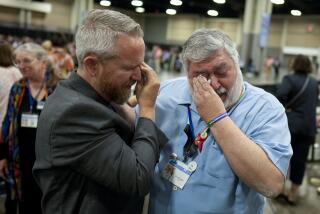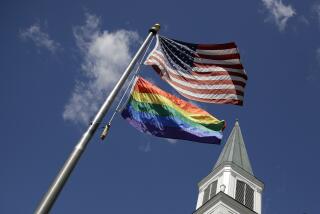3 Merging Lutheran Groups Celebrate Their New Status
- Share via
COLUMBUS, Ohio — Delegates from three merging Lutheran denominations, meeting together for the first time, celebrated their newly prominent status in U.S. Protestantism this week.
The new Evangelical Lutheran Church in America, now the fourth largest denomination, will not have as many people asking “Which Lutheran group are you?” said Presiding Bishop David Preus of the American Lutheran Church, one of the merging partners.
“We will have more visibility as we start new congregations or explain ourselves on a public issue,” Preus told reporters.
In voting for presiding bishop of the new church, Preus led on the first four ballots cast by more than 1,000 delegates.
But on the ninth and final ballot Friday afternon, the victory went to Bishop Herbert W. Chilstrom, 55, who has been bishop of the Lutheran Church in America’s Minnesota district since 1976.
The vote was 626 to 411 over Preus. The candidate running third, the Rev. William Lazareth, a New York City pastor, was eliminated after the eighth ballot.
Chilstrom, greeted by prolonged applause, said he was filled with a sense of gratitude. His voice cracking, he said, “That (gratitude) begins with my wife and my best friend,” referring to his wife, Corrine, a clergywoman in the American Lutheran Church.
A former dean and Bible professor at Luther College, in Teaneck, N.J., Chilstrom told a news conference that he is confident that the new Lutheran church can buck the 20-year-old trend of declining membership in mainline Protestant churches.
Chilstrom said he was the one who proposed that the new church have the word “evangelical” in its title--”to recapture” the Christian tradition of proclaiming the Gospel and not allow the word to be synonymous only with conservative Protestant groups.
Regional Bishops
The four-day convention opened Thursday with delegates ratifying unanimously and without hoopla the new church’s constitution and bylaws. When the constituting convention ends Sunday, all national offices are expected to be filled.
In June and July, regional bishops will be elected by new synods, or districts, including three in California where no heavily favored candidates exist. The denomination becomes operational Jan. 1.
The actions will bring a decade-long realignment of American Lutheranism almost to a close. In coming months, some theologically conservative churches are expected to drop out.
To the degree that disenchanted congregations choose to stay out, the liberal-to-moderate complexion of the Evangelical Lutheran Church in America will be enhanced.
With a total of 5.3 million members, the new church is twice the size of the 2.6-million-member Lutheran Church-Missouri Synod, a theologically and politically conservative denomination.
The merged body is more likely now, say church leaders, to be viewed as the principal voice for U.S. Lutheranism and a leading influence in Protestant circles. Only the Southern Baptists, United Methodists and the predominantly black National Baptists have larger memberships. The new Lutheran church, in fact, replaces the 3.1-million-member Presbyterian Church (USA), the product of a 1983 merger, as the fourth largest Protestant denomination.
Ethnic Divisions
Over the last half-century most of Lutheranism, through a series of smaller mergers, moved out of its ethnic divisions stemming from the churches’ German and Scandinavian roots.
But the new alignment along liberal-conservative lines began in the 1970s. The Missouri Synod Lutherans, then one of the three big Lutheran bodies of comparable size, began to apply pressure against “moderate” elements in its academic ranks and leadership positions to reject anyone not adhering to biblical literalism.
The moderates departed and formed in 1978 the Assn. of Evangelical Lutheran Churches. Its leaders urged the relatively liberal Lutheran Church in America and the middle-of-the-road American Lutheran Church to abandon any hopes of unity with the Missouri Synod.
Instead, the breakaway AELC, now 112,000 members in 276 congregations, urged unity among the three more like-minded bodies. The three groups, whose initials AELC, ALC and LCA led to jokes about the confusing alphabet soup of Lutheran denominations, established a commission to work out the merger in 1982 and voted approval of the results last year in concurrent conventions.
The American Lutheran Church congregations, required to add their assent, approved the merger by a 4-1 margin in results announced in March.
No Female Bishops
“Even though we are not the same, God calls us to be one,” said the Rev. Barbara K. Lundblad, a Manhattan pastor who delivered the opening convention sermon here Thursday. Lundblad is regarded to have a good chance to be elected a regional bishop in the later New York Synod convention. At present there are no female bishops in any U.S. Lutheran church. “Make us one, not number one, and help us to know the difference,” Lundblad said in prayer during the service. “Let our evangelism be in the shelters as well as the subdivisions, in the small towns as well as the boom towns.”
The merger is being consummated as public attention has focused on questionable fund-raising practices of TV evangelists, but LCA Bishop James Crumley minimized the possible effect on the new church, which has a $112 million budget for 1988.
Crumley said there is one great difference between the “electronic ministries” and Lutheran churches: “Our people are trained for and expect strict accountability . . . all the way through.”
Missouri Synod
The president of the Missouri Synod Lutherans, the Rev. Ralph A. Bohlmann, extended cordial greetings and congratulations to delegates Friday.
But in a press statement released earlier this week, the conservative denomination said, ‘We will not be in the new church because we believe that God’s Word calls for us to have complete agreement in what we believe and teach before we demonstrate external unity. . . . Unfortunately, we do not now have such agreement.” The statement said the Missouri Synod will continue to cooperate with the new church in such matters as relief and refugee work.
Some of the congregations unhappy to see the American Lutheran Church join the merger were to give form and direction this weekend in Minneapolis to the newly formed Assn. of American Lutheran Churches. The Rev. James Minor of St. Paul estimated that as many as 100 churches may join the group.
One Southern California pastor whose ALC congregation voted against the merger estimated that as many as 20 other churches in the region had also said no.
‘Wait and See’
But Bishop Nelson Trout, who has been the ALC bishop based in Los Angeles, said he learned that 16 churches in his district voted against the merger.
“And now I’m beginning to hear from three churches who had once said they were not going to be a part of the new church that they are now going to wait and see,” Trout said.
Trout, 66, who was the only black bishop in the ALC, said he was willing to be nominated for the Los Angeles synod of the new church.
Bishop Stanley Olson, 60, who headed the Lutheran Church in America’s Pacific Southwest district from Los Angeles, said in an interview that he was only interested in being a candidate to lead the 220 churches of the Northern California synod.
The San Diego Synod, which includes Orange, Riverside and San Bernardino counties, has no resident bishop from the old churches.
Olson said that the Rev. Bob Miller of Fullerton might have an advantage for that position because of the exposure he received in the region as head of the merger transition team. The Rev. Ed Peterson, a La Canada pastor, enjoys the same edge in consideration as bishop for the Los Angeles Synod where he directed the transition team.
“There has been almost no campaigning, however,” Olson said. “Certainly anyone who campaigns too hard is not going to be elected because of a rebellion against any secular-type political election,” he said.
Threat of Disruption
Few surprises occurred during the convention here, although the Pittsburgh-based Denominational Ministry Strategy organization has threatened to disrupt the meeting today ).
The activist group has called for the reinstatement of two former Lutheran Church in America clergy, the Revs. D. Douglas Roth and Daniel Solberg, who were dismissed for defiance of the church’s authority. Roth was in the news in 1984 when he barricaded himself in his church after being ordered out by a judge. Solberg was arrested after disrupting the 1986 LCA convention in Milwaukee.
The activist coalition, in its March newsletter, attacked Lutheran investments in companies doing business in South Africa and called for investigation of alleged money-laundering by certain banks and businesses.
More to Read
Sign up for Essential California
The most important California stories and recommendations in your inbox every morning.
You may occasionally receive promotional content from the Los Angeles Times.













